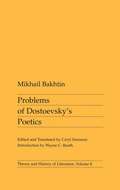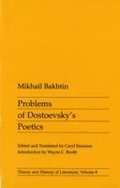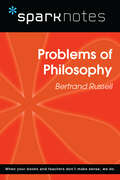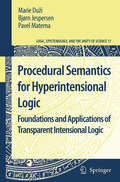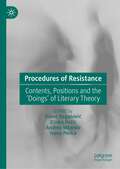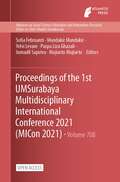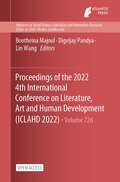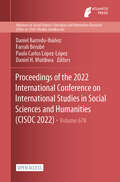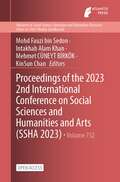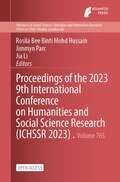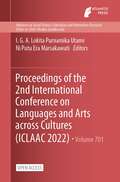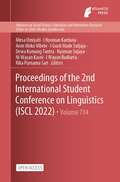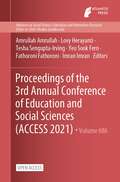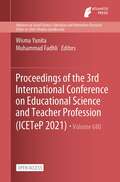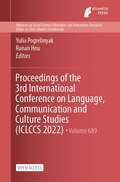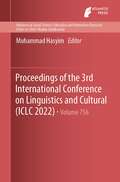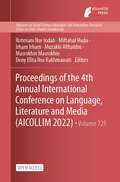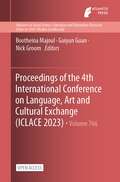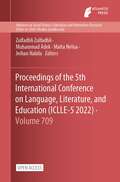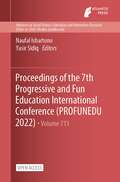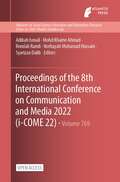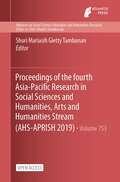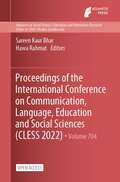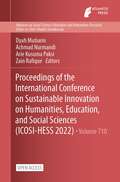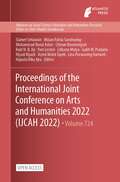- Table View
- List View
Problems of Dostoevsky's Poetics (Theory and History of Literature #8)
by Mikhail BakhtinThis book is not only a major twentieth-century contribution to Dostoevsky&’s studies, but also one of the most important theories of the novel produced in our century. As a modern reinterpretation of poetics, it bears comparison with Aristotle.
Problems of Dostoevsky's Poetics
by Mikhail M. Bakhtin Wayne BoothThis English-language edition of Problems of Dostoevsky's Poetics offers three levels of explanatory apparatus. They are (1) Bakhtin's own footnotes, which are numbered, are reproduced at the end of each chapter. (2) Translator's notes, which are lettered, appear at the bottom of the relevant page and cover such problems as critical or generic terminology, puns, untranslatable terms, and the occasional identification of important literary contexts. (3) An asterisk (*) after a proper name or work indicates that biographical information or an explanatory note can be found in the "Glossary of Proper Names and Works" at the end of the volume.
Problems of Philosophy (SparkNotes Philosophy Guide)
by SparkNotesProblems of Philosophy (SparkNotes Philosophy Guide) Making the reading experience fun! SparkNotes Philosophy Guides are one-stop guides to the great works of philosophy–masterpieces that stand at the foundations of Western thought. Inside each Philosophy Guide you&’ll find insightful overviews of great philosophical works of the Western world.
Procedural Semantics for Hyperintensional Logic
by Marie Duží Bjorn Jespersen Pavel MaternaThe book is about logical analysis of natural language. Since we humans communicate by means of natural language, we need a tool that helps us to understand in a precise manner how the logical and formal mechanisms of natural language work. Moreover, in the age of computers, we need to communicate both with and through computers as well. Transparent Intensional Logic is a tool that is helpful in making our communication and reasoning smooth and precise. It deals with all kinds of linguistic context in a fully compositional and anti-contextual way.
Procedures of Resistance: Contents, Positions and the 'Doings' of Literary Theory
by Davor Beganović Zrinka Božić Andrea Milanko Ivana PericaThis volume explores the state of literary theory today, decades after the repeatedly proclaimed end of theory. It builds on the idea that theory is historically constituted as it is “always becoming something else” as Leslie Fiedler claimed in the 1950s, arguing that the historical constitution of theory relies on theory’s procedural nature. In order to assess theory’s procedural challenge to the fundamental notions that all the disciplines within an episteme have brought to the fore, it addresses these questions: What are the procedures theory has relied on? Are they a secret to its resistance, or is resistance its primary procedure? And if so, a resistance to what? Secondly, if resistance were theory’s principal vehicle, at which point does resistance, conceptualized only procedurally (as resisting something, questioning anything, criticizing whatever), display hallmarks of a disciplinary closure that must call for new resistances, and perhapsfor a fundamentally another kind? The book turns to what theory does in order to avoid a partial answer to what theory is.
Proceedings of the 1st UMSurabaya Multidisciplinary International Conference 2021 (Advances in Social Science, Education and Humanities Research #708)
by Sofia Februanti Mundakir Mundakir Yelvi Levani Puspa Liza Ghazali Jumadil Saputra Mujiarto MujiartoThis is an open access book. Internationalization is one aspect of becoming qualified in this globalization era, especially for higher education levels. In this particular era when everyone is locked down due to Covid 19 Virus, the academic activity must still run. It is correlated with vision of Universitas Muhammadiyah Surabaya as an international standard university so that it can compete with universities at national or international level. During Pandemy, many obstacles occur then it is also led with many opportunities.
Proceedings of the 2022 4th International Conference on Literature, Art and Human Development (Advances in Social Science, Education and Humanities Research #726)
by Bootheina Majoul Digvijay Pandya Lin WangThis is an open access book.The 4th International Conference on Literature, Art and Human Development (ICLAHD 2022) was successfully held on October 28th-30th, 2022 in Xi’an, China (virtual conference). ICLAHD 2022 brought together academics and experts in the field of Literature, Art and Human Development research to a common forum, promoting research and developmental activities in related fields as well as scientific information interchange between researchers, developers, and engineers working all around the world.We were honored to have Assoc. Prof. Chew Fong Peng from University of Malaya, Malaysia to serve as our Conference Chair. The conference covered keynote speeches, oral presentations, and online Q&A discussion, attracting over 300 individuals. Firstly, keynote speakers were each allocated 30-45 minutes to hold their speeches. Then in the oral presentations, the excellent papers selected were presented by their authors in sequence.
Proceedings of the 2022 International Conference on International Studies in Social Sciences and Humanities (Advances in Social Science, Education and Humanities Research #678)
by Daniel Barredo-Ibáñez Farrah Bérubé Paulo Carlos López-López Daniel H. MutibwaThis is an open access book. CISOC’2022 – The 2022 International Conference on International Studies in Social Sciences and Humanities, invites the entire scientific, academic and professional community to present their contributions, which can be written in French, English, Spanish or Portuguese. All papers (full articles) will be submitted to a “double-blind review” by at least two members of the Scientific Committee, based on relevance, originality, importance and clarity. The papers presented must bring discussions on actual theoretical, or methodological, or empirical workshop proposals around Social Sciences and Humanities. The topics proposed for the Conference are related to: Psychology, Education, History, Linguistics and language, Political science, Religious studies, Philosophy, Globalization, Humanities, Archaeology, Anthropology, Inter-cultural studies, Development, Geography, Library and Information Sciences.
Proceedings of the 2023 2nd International Conference on Social Sciences and Humanities and Arts (Advances in Social Science, Education and Humanities Research #752)
by Mohd Fauzi bin Sedon Intakhab Alam Khan Mehmet Cüneyt Bi̇rkök KinSun ChanThis is an open access book. With the progress of social civilization, social science and its research are becoming more and more important. Theoretically and practically, the study of social phenomena and social problems and the development of prosperous social sciences are the eternal themes of human beings. At present, social science research and its results can hardly meet the needs of social development, especially the unscientific evaluation of social science results, which has aroused great concern from all walks of life, and has produced dirt and questions on social science, thus affecting the proper development of social science.Max Weber once said that "the most important function of social science in modern times is to keep people "clear-headed" and to resist the delusions of "prophetic legislators". "Humanities and arts are the process of perceiving, realizing, thinking, manipulating, and expressing objective or subjective objects through capturing and excavating, feeling and analyzing, integrating and applying, or displaying the stage results in the form obtained through feeling (seeing, hearing, smelling, touching).The social sciences and humanities and arts contain content that will directly affect our lives and the way society functions. And by reacting to today's increasingly intricate problems and situations through systematic and professional discussions, they will further contribute to the improvement of institutions and the development of society. By thinking about issues and looking at problems and the world from different perspectives by putting the two together, it may be possible to have more comprehensive, appropriate, and better responses; for example, the development of laws requires a deeper understanding of the environment in which they are implemented; international trade requires a certain understanding of the customs of different countries; and the development of tax and economic policies requires a certain understanding of the population, consumer demand, etc.
Proceedings of the 2023 9th International Conference on Humanities and Social Science Research (Advances in Social Science, Education and Humanities Research #765)
by Rosila Bee Binti Mohd Hussain Jimmyn Parc Jia LiThis is an open access book. 2023 9th International Conference on Humanities and Social Science Research (ICHSSR 2023) will be held on April 21-23, 2022 in Beijing, China. Except that, ICHSSR 2023 is to bring together innovative academics and industrial experts in the field of Humanities and Social Science Research to a common forum. We will discuss and study about EDUCATION , SOCIAL SCIENCES AND HUMANITIES, INTERDISCIPLINARY STUDIES and other fields. ICHSSR 2022 also aims to provide a platform for experts, scholars, engineers, technicians and technical R & D personnel to share scientific research achievements and cutting-edge technologies, understand academic development trends, expand research ideas, strengthen academic research and discussion, and promote the industrialization cooperation of academic achievements. The conference sincerely invites experts, scholars, business people and other relevant personnel from universities, scientific research institutions at home and abroad to attend and exchange! The conference will be held every year to make it an ideal platform for people to share views and experiences in financial innovation and economic development and related areas.
Proceedings of the 2nd International Conference on Languages and Arts across Cultures (Advances in Social Science, Education and Humanities Research #701)
by I. G. A. Lokita Purnamika Utami Ni Putu Era MarsakawatiThis is an open access book. The 2nd International Conference on Languages and Arts across Cultures (ICLAAC) aims to provide a venue for lecturers, teachers, researchers, as well as language and art professionals to share their insights, experiences, and ideas. This conference will also bridge the knowledge gap by presenting their works on languages and arts issues. The event will provide limitless resources and opportunities to interact with prominent scholars in this field worldwide. This will allow us to significantly expand our existing global network.The conference theme will give us a better understanding of humans through languages and arts. The development of cultural value occurring in today's global communities is certainly a stimulant for artist and language users in creating their artifacts.Restoring cross-cultural understanding is a bridge to understanding the complexities of language, culture, and the role of art in them. Cross-cultural understanding refers to people's attempts to understand one another, particularly between people of different cultural backgrounds. Significant cultural and artistic creations are incorporated into a language that promotes scholarly debate and scientific comprehension. As an attempt to minimize the spread of covid-19 virus, the conference presenters will be invited to present their papers online via zoom.
Proceedings of the 2nd International Student Conference on Linguistics (Advances in Social Science, Education and Humanities Research #734)
by Mirsa Umiyati I Nyoman Kardana Aron Meko Mbete I Gusti Made Sutjaja Dewa Komang Tantra Nyoman Sujaya Ni Wayan Kasni I Wayan Budiarta Rika Purnama SariThis is an open access book. Linguistics as a field of study discussing languages plays a fundamental role in the life of humans. It affects the human way of thinking in various aspects. In turn, there is a pervasive influence of language on our daily lives. The impact is that the work of linguists is no longer only managing language in one discipline, but relating and interconnecting the linguistics with other fields at a further level. Linguistic studies have now been carried out in various fields including psychology, anthropology, neuroscience, law, philosophy, computer science, communications, and education. Linguistics enthusiasts find practical solutions for their linguistic training in the computer, law, and forensic industries, teaching foreign languages and English as a second language, translation and interpretation, speech pathology, lexicography, and policymaking in government and education. Nowadays, these jobs are, however, no longer operational but encounter many challenges, especially in the global era.The digital revolution has created new avenues for language use and new communication modalities. The existence of technology mediates our linguistic and social interactions. The pervasive influence of technology on human development has the potential to influence language acquisition and change social behavior. In this global era, many challenges in human life arise. Our brave new digital world has caused some discord for language activists – and if harsh text speakers do not feel good, woe ensues our new diet of round-shaped emojis. Our language and our relationship to language have developed to keep pace with cultural changes.Furthermore, since the spread of the COVID-19 pandemic, society has been carrying out communication online through the internet and social. To , society has been accustomed to doing it that way. One of the challenges linguistics studies are facing is the implementation of appropriate language capacity. There are conditions for the use of inaccurate languages according to standardized rules in communication through online media. To solve this, reciprocal interactions are also important for creating a pool of different perspectives among the smart human community. In total, digital technologies are also changing the ways we learn and teach, as well as the ways we compose and research. These changes are occurring throughout the academy, including the humanities — a set of disciplines less associated with technology.In an effort to vanquish the challenges trending in the linguistic study in order to depict the future perspectives on it established in the description above, fresh ideas from the younger generations are needed. For that purpose, the Graduate School of Linguistics, the Postgraduate Program University of Warmadewa in collaboration with other institutes presents an international academic discussion forum in the form of a conference. This event is themed “The 2nd Student Conference on Linguistics: Trends and Future Perspectives in Language study and Language Teaching”. Through the forum students from various parts of the world are expected to share bright and innovative ideas to discover solutions to the problems and challenges faced by linguistics today and in the coming future.
Proceedings of the 3rd Annual Conference of Education and Social Sciences (Advances in Social Science, Education and Humanities Research #686)
by Amrullah Amrullah Lovy Herayanti Tesha Sengupta-Irving Yeo Sook Fern Fathoroni Fathoroni Imran ImranThis is an open access book.Faculty of Teacher Training and Education of the University of Mataram proudly presents the 4th Annual Conference on Education and Social Science (ACCESS) in 2022. ACCESS is an iconic international scientific forum which discusses new ideas and innovations—especially those related to education and pedagogy, generally in relation to sciences and technology. Since 2019, ACCESS has been attended by hundreds of participants from various different countries such as the United States, Malaysia, Australia, Philippines, Japan, Singapore, and so on.
Proceedings of the 3rd International Conference on Educational Science and Teacher Profession (Advances in Social Science, Education and Humanities Research #680)
by Wisma Yunita Muhammad FadhliThis is an open access book.Uncovering the Languages, Sciences, and Teaching profession Practice during the Covid-19 Pandemic.
Proceedings of the 3rd International Conference on Language, Communication and Culture Studies (Advances in Social Science, Education and Humanities Research #689)
by Yulia Pogrebnyak Runan HouThis is an open access book. International Science and Culture Center for Academic Contacts (ISCCAC) is pleased to announce The 3rd International Conference on Language, Communication and Culture Studies (ICLCCS 2022). The conference was held on August 12-13, 2022. Due to the COVID-19 pandemic, the conference was held in on-line format. ICLCCS 2022 covers a number of problems, such as: prospects for the development of linguistics, modern approaches and topical issues of teaching foreign languages, information technologies as a medium of language existence, language as the means of intercultural communication, problems of modern translation studies and other topical issues in the interrelated fields of language, communication and culture.
Proceedings of the 3rd International Conference on Linguistics and Cultural (Advances in Social Science, Education and Humanities Research #756)
by Muhammad HasyimThis is an open access book.Research and teaching activities in the fields of language, literature and culture are still being carried out even during the Covid -19 era that hit the world. It is undeniable that the results of research and learning of language, literature and culture at this time were a bit hindered because most activities were carried out from home.During the Covid-19 period, which started in early 2020, practically more activities were done at home. Likewise, institutions during the Covid-19 era were carried out online. For example, the Language Agency continues to carry out activities, but it is carried out online, such as online webinars that contribute to the wider community in accordance with the duties and functions of the Language Agency, carried out using a hybrid method or completely online. Various events are packaged creatively and innovatively to produce a new spirit in speaking.Research and teaching of language, literature and culture during the Covid-19 period resulted in many amazing innovations and creativity in line with technological developments. Covid-19 has inspired many in research on language, literature and culture. In the field of language, you can see research on the language used in Covid-19, such as said cases of suspected respiratory tract infection, ODP (People Under Monitoring), confirmed cases (a person who is late known to be infected with Covid-19, etc. That’s the content -Content on YouTube about the use of language is a hot object of research to research.In terms of culture, the Government is making various efforts to break the chain of the spread of the Covid-19 pandemic in a massive and systematic manner. Covid-19 is not only a deadly virus, but has a domino effect that is also terrible. One of the policies used by the government in preventing and controlling the spread of Covid-19 is implementing the Large-Scale Social Restrictions (PSBB) policy.As an investment, culture also requires strategies and enablers so that it is able to achieve the target of the happiness and welfare of the Indonesian people. This strategy is implemented through providing for a diversity of cultural expressions, developing cultural practices, utilizing cultural promotion objects, accelerating institutional reform, and increasing the government’s role as a facilitator. Teaching issues, especially teaching methods of language, literature and culture, need to be highlighted in terms of IT-based innovation and creativity after Covid-19. How especially teaching methods in applying the material. Research on learning methods has also been carried out a lot, especially methods that focus on students entering the new normal era or the new era after Covid-19 with innovative research and learning of language, literature and culture. It is interesting to reveal a major event, namely the 3rd International Conference on Linguistics and Cultural Studies sponsored by the Faculty of Cultural Sciences, Hasanuddin University, Makassar.
Proceedings of the 4th Annual International Conference on Language, Literature and Media (Advances in Social Science, Education and Humanities Research #725)
by Rohmani Nur Indah Miftahul Huda Irham Irham Muzakki Afifuddin Masrokhin Masrokhin Deny Efita Nur RakhmawatiThis is an open access book. AICoLLiM is the annual conference on the area of language, literature and media. It provides a forum for presenting and discussing the expanding paradigm, latest innovations, results and developments in language, literature and media. The conference provides a forum for lecturers, students, researchers, practitioners and media professionals engaged in research and development to share ideas, interact with others, present their latest works, and strengthen the collaboration among academics, researcher and professionals.
Proceedings of the 4th International Conference on Language, Art and Cultural Exchange (Advances in Social Science, Education and Humanities Research #766)
by Bootheina Majoul Guiyun Guan Nick GroomThis is an open access book.The 4th International Conference on Language, Art and Cultural Exchange (ICLACE 2023) will be held on May 19–21, 2023 in Hangzhou, China. Culture includes language, which is a special cultural phenomenon. For culture, most scholars agree that it mainly includes two aspects: material culture and spiritual culture. Specific examples to show cultural phenomena will be of great benefit to our understanding. Some examples of material culture are listed here: Indian women wear saris, Japanese like to eat sashimi, and Chinese like to shake hands when meeting each other. These are various manifestations of material culture in different nations.Language is the mode of transmission of culture. Language is one of the most important ways of thinking and cultural exchange of human beings, which is actually the manifestation of the formation and transmission of culture. Because of thinking, human beings gradually create culture in the continuous social practice, and then spread their national culture to each other in the continuous language exchange.Since ancient times, art and culture have been going hand in hand and complementing each other. On the one hand, art is an important connotation and component of culture, and the progress of art is the driving force of cultural development. On the other hand, culture is the source and content of art, and the prosperity of culture is the key to improve the level of art. On the other hand, culture is the source and content of art, and the prosperity of culture is the key to improving the level of art. Therefore, whether it is culture or art, it is not only a symbol of an era, a representation of people’s life style, but also a guide to the direction of social development.The relationship between language, art and cultural communication is a hot topic for many scholars to study at present. Therefore, an academic conference is set up for authors to discuss related research issues and exchange new ideas, hoping that scholars can burst out more excellent and valuable ideas in this conference.ICLACE 2023 is to bring together innovative academics and industrial experts in the field of Literature, Art and Cultural Exchange research to a common forum. The primary goal of the conference is to provide a platform for scientists, scholars, and engineers from all over the world to present ongoing research activities, fostering the research and business relations and promoting scientific information interchange and cooperation between all the participants.
Proceedings of the 5th International Conference on Language, Literature, and Education (Advances in Social Science, Education and Humanities Research #709)
by Zulfadhli Zulfadhli Muhammad Adek Malta Nelisa Jeihan NabilaThis is an open access book. The 5th ICLLE will be held in Padang, Indonesia in July 27th, 2022. The conference aims to provide a forum for researchers, practitioners, and professinals from the industry, academia and government to discourse on research and development, professional practice in linguistics, literature and education.
Proceedings of the 7th Progressive and Fun Education International Conference (Advances in Social Science, Education and Humanities Research #711)
by Naufal Ishartono Yasir SidiqThis is an open access book. Education is an effort to educate people, through education the quality of human life becomes better, and it is captured and realized by all Muhammadiyah universities in Indonesia, especially from the Faculty of Teacher Training and Education Science. The problem that occurs is the need for a lot of innovation related to the implementation of learning in the classroom so that the learning process becomes more enjoyable. Thus, students will be more eager to learn and their academic achievement will be better, which of course has implications for the quality of education which is also better. Therefore, the Association of Muhammadiyah Higher Education Teaching Institutions (ALPTK-PTM) in collaboration with Universitas Muhammadiyah Sorong (UNAMIN) dan Universitas Pendidikan Muhammadiyah Sorong (UNIMUDA) as the local committee initiated the holding of The 7th Progressive and Fun Education International Conference (The 7th Profunedu) which was held on 8-9 September 2022. The conference invited eight invited speakers from international speakers and Indonesian speakers. In addition, the conference was also attended by 115 participants and presenters with 107 papers listed. The 7th Profunedu this time collaborated with the Atlantis Press in the paper publication process. From 107 papers listed, 30 papers were selected to be published by Atlantis Press as publishing partners in this conference.
Proceedings of the 8th International Conference on Communication and Media 2022 (Advances in Social Science, Education and Humanities Research #769)
by Adibah Ismail Mohd Khairie Ahmad Romlah Ramli Norhayati Mohamad Hussain Syarizan DalibThis is an open access book.We would like to welcome you to the official website of the 8th International Conference on Communication and Media 2022 (i-COME’22). This biennial event is organized by the Department of Communication, School of Multimedia Technology and Communication, Universiti Utara Malaysia and will be held on 1 – 3 October 2022, virtually. The conference provides an opportunity to researchers, practitioners and students to interact and share their experience and knowledge in communication and media. I-COME’22 provides an excellent international platform for knowledge sharing in the areas of communication and media, as well as providing an ideal environment for new collaborations and meeting scholars and experts in the areas of communication and media. I-COME’22 welcomes participants from all over the world who are interested in communication and media, especially how globalization and current situation affects the future landscape of the fields. The aim of the conference is to provide platform for scholars, researchers and practitioners from both academia and industry to meet and share the advanced development and changes in both areas. The conference also hopes to discuss the innovative discovery of research level and promote international scientific cooperation and exchange of ideas among researchers and practitioners. Our conference relies on a wide range of challenges and issues in the fields of communication and media which will be presented through keynote addresses, plenary sessions, presentations by distinguished scholars and practitioners, and doctoral colloquium which is specially designed for post graduate students to share their experiences. The highlight of the conference will be the award presentation during the closing ceremony which will be given as recognition to the outstanding work of the selected researchers.
Proceedings of the fourth Asia-Pacific Research in Social Sciences and Humanities, Arts and Humanities Stream (Advances in Social Science, Education and Humanities Research #753)
by Shuri Mariasih Gietty TambunanThis is an open access book.According to Castells, power now rests in networks: “the logic of the network is more powerful than the powers of the network” (quoted in Weber, 2002, p. 104) – it is whether nation states or local communities are deeply affected, especially by inclusion in and exclusion from the global networks that structure a various sectors in society at any level. Thus it is also crucial look closely at exclusion from and inclusion in different kinds of social structures where connectivity and access to networks are essential, being aware that people at the bottom are those who, with nothing to offer the network, are excluded. Castells’ arguments shows us how the new forms of network society offer challenges in a way that despite the disappearance of conventional ties, exploitation, marginalization, exclusion and differentiation remain.In what follows, scholarships are invited to build an academic discussion on characterizing the structure and dynamics of societies in the world of the twenty-first century. Thus, scholar may come to look at the meaning of being in a network society by examining the role of network society within the complexity of socio-cultural, political and economic circumstances in strengthening the role of science in overcoming local, national, regional and global problems. But scientific research is also required to identify a wide variety of solutions to societal problems enhanced by the network society, which no longer relate solely to a particular discipline, but are multi- and trans-disciplinary. In addition, recent research has changed the traditional role of academia, demanding more collaboration in the production of science, not only among universities, but also among researchers, social practitioners and policymakers.Considering these issues, the fourth Asia-Pacific Research in Social Sciences and Humanities (APRiSH) will be hosted by the Faculty of Social and Political Sciences, Universitas Indonesia (FISIP UI) in 2019 under the theme The Network Society: Continuity and Change. Scientific inputs from all parts of the world are welcome, academically and practically. Various perspectives, based on mono-disciplinary, multi-disciplinary or trans-disciplinary research are expected to examine the problems and contribute to solutions.
Proceedings of the International Conference on Communication, Language, Education and Social Sciences (Advances in Social Science, Education and Humanities Research #704)
by Sareen Kaur Bhar Hawa RahmatThis is an open access book.The 3rd International Conference on Communication, Language, Education and Social Sciences (CLESS 2022) will be held on 25-27 July 2022. This year’s conference will be a part of the bigger Digital Future Congress (DIFCON) comprising of various other conferences in different fields and will be held online. CLESS 2022 is unique in which it combines communication, language, education, and social science in an international academic conference. The aim of CLESS 2022 is to offer a platform for both local and international academics, educators, researchers and other professionals to meet, share and discuss latest research, trends, ideas and innovation in the field of communication, language, education, psychology and social sciences. The conference is aimed to provide a platform for young researchers as well as to support and encourage other researchers to present their research, to network within the international community of researchers and to share and seek the insight and advice of successful senior researchers all over the world during the conference.
Proceedings of the International Conference on Sustainable Innovation on Humanities, Education, and Social Sciences (Advances in Social Science, Education and Humanities Research #710)
by Dyah Mutiarin Achmad Nurmandi Arie Kusuma Paksi Zain RafiqueThis is an open access book.This proceeding consists of research presented in ICOSI UMY, on 20-21 July 2022 at Universitas Muhammadiyah Yogyakarta. The conference covers the topic of governance, international relations, law, education, humanities, and social sciences. The COVID-19 pandemic first time that occurred in 2019, has brought many changes that constrain all countries to adapt quickly. The crisis has shown vulnerabilities and gaps in several primary systems, including healthcare, social protection, education, value chains, production networks, financial markets, and the ecosystem.One of the efforts that each country can take to rise from the COVID-19 pandemic is through strengthening multilateralism, international solidarity, and global partnerships. Hence, this conference raises the central theme “Strengthening Global Partnership for Resilience.” This theme covers sub-themes that allow prospective scholars to submit their papers for ‘Virtual Conferences’ presentation under the following scopes: Social Sciences, Humanities, Educations, and Religious Studies. Presented papers will also get a chance to be published in our remarkable partner publishers. Through the International Symposium on Social, Humanities, Education, and Religious Studies (ISSHERS) and Asian Conference on Comparative Laws (Asian-COL), we hope that participants will express their innovative and creative ideas to provide benefits and contribute knowledge to strengthen global partnerships among countries.Finally, all 75 papers published in this proceedings are expected not only as research output but can be developed further into prototypes or evidence for policy making.
Proceedings of the International Joint Conference on Arts and Humanities 2022 (Advances in Social Science, Education and Humanities Research #724)
by Slamet Setiawan Wulan Patria Saroinsong Muhammad Nurul Ashar Chinun Boonrongrut Rojil N. B. Aji Yuni Lestari Lillyana Mulya Galih W. Pradana Riyadi Riyadi Azmil Mohd Tayeb Lina Purwaning Hartanti Hujuala Rika AyuThis is an open access book. This joint conference features four international conferences: International Conference on Education Innovation (ICEI), International Conference on Cultural Studies and Applied Linguistics (ICCSAL), International Conference on Research and Academic Community Services (ICRACOS), and International Conference of Social Science and Law (ICSSL).It encourages dissemination of ideas in arts and humanities and provides a forum for intellectuals from all over the world to discuss and present their research findings on the research areas. This conference was held in Surabaya, East Java, Indonesia on September 10, 2022 – September 11, 2022.We are inviting academics, researchers, and practitioners to submit research-based papers or theoretical papers that address any topics within the broad areas of Arts and Humanities.
